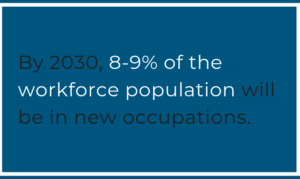Why the Pain of Same is Hurting Enrollment Numbers
Evolve now or put your institution’s enrollment numbers at risk
In the (then) breakthrough book published nearly a decade ago, The 2020 Workplace: How Innovative Companies Attract, Develop, and Keep Tomorrow’s Employees Today, the authors discuss many workplace disruptors including this one: “Fast-breaking technological breakthroughs in new products and services will create demand for new jobs using more complex skills.”
For years, futurists have been suggesting this day would come and now that it’s here, how is your institution meeting the demands of this rapidly changing workforce? With pressure on individuals and businesses alike to skill up for the future, if you aren’t adapting your program offerings, you’re putting your institution’s enrollment numbers—and future—at risk.
Why change is imperative
According to Workplace Trends, there are six megatrends that will change the workforce landscape:
- Digital technology
- Increased data
- Diversity
- Group collaboration
- Fresh leadership
- HR adaptations
Whatever your reasons for not changing, know this: the game of higher education for working adults has changed. Will you adapt and overcome? Or will you become obsolete?
Upskilling despite various unknown
In a recent Deloitte report, the authors captured the mood astutely by subtitling it an “era of change and uncertainty.” Perhaps the most challenging aspect to address is defining the skills needed for the future. In the report, 55% of executives said there is too much of a mismatch in skills of today versus those that will be needed down the road.
That sentiment is shared in nearly equal measure with half of working adults believing it will be essential to develop new skills to be able to keep up with changes on the job.
While employees, executives and institutions ponder the conundrum, some organizations are being proactive. Retail giant Amazon has taken matters into its own hands by investing $700M to upskill its workforce by 2025.
Institutions already embracing change
To appease adult learners, you need to offer flexible programs to help them skill up in specific fields and areas. Because of the rapid pace of change in technology, and responsibilities adult learners have, they may no longer be interested in a four-year degree. Certifications and special programs that cover topics deeply are more in line with what they need. But what types of training do they need? Uncertainty is guaranteed and the only way to confront it is through change.
Unity College in Maine offers graduate certificate programs in sustainability and GI Science and an online learning program that serves up five-week undergraduate terms and eight-week graduate cycles.
University of Washington Continuum College has a Career Accelerator program in which students may choose from four different modality paths they can take to obtain credentials to advance their careers: 1) self-paced, asynchronous online coursework; 2) two-month, accelerated in-person learning; 3) online group class lasting five to nine months; or a 4) nine-month part-time in person class meeting once weekly.
University of Miami has specialized master’s programs that are accelerated and take one year to complete.
Northeastern offers graduate certificates in more than two dozen topics in traditional (marketing and business administration) and emerging topics (technological entrepreneurship).
How to develop programs that meet future needs
Just as collaboration is a skill expected to be in demand (and not replaced by AI in the future), widening your collaboration circle to develop new programs will be key. You may need to look at other departments within your institution to offer a cross-disciplinary certification or program.
Additionally, seek out area business leaders to learn their needs and predictions for skills needed. In the Washington, D.C., metro area, institutions and large area employers like Amazon Web Services, Northrop Grumman and Under Armour have collaborated to form a partnership to determine the skills necessary for entry level workers in two undergraduate credentials. The program is mutually beneficial because students who complete the program get priority internships and interviews at partner businesses.
Finally, ask your adult learners what they want. It may seem oversimplified but surveying former students may reveal patterns in their needs that will help give you direction in meeting new demands.
Takeaway
Institutions are not simply awarding degrees and certifications to students; they are preparing the future workforce. To do so effectively, schools need to determine the specific technological and soft skills needed by partnering with industry professionals and other departments at the institution to develop flexible programs that meet the needs of adult learners.
What is your school doing to meet the needs of adult learners adapting to the rapidly changing workforce? Comment below.


